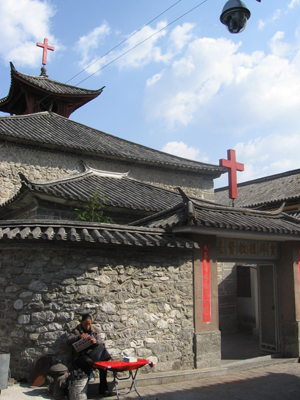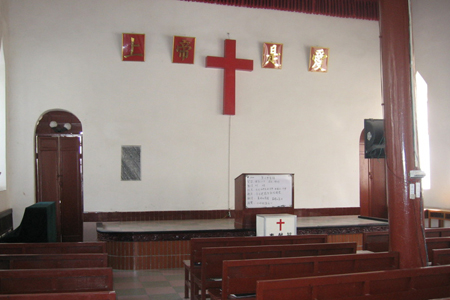| |
 |
 |
 |
| Comment on this report, or find other reports. |
 |
| Our Mystery Worshippers are volunteers who warm church pews for us around the world. If you'd like to become a Mystery Worshipper, start here. |
 |
| Find out how to reproduce this report in your church magazine or website. |
|
|
| 1939: Dali
Protestant, Dali, Yunnan, China |
 |
 |
 |
Mystery Worshipper:
Amaranta.
The church:
Dali Protestant, Dali, Yunnan, China.
Denomination:
Three-Self Patriotic Movement for Protestants, officially known
as the National Committee of the Three-Self Patriotic Movement
of the Protestant Churches in China, and colloquially called
the Three-Self Church. This is the official Chinese government-sanctioned
Protestant body in China. Three-Self stands for self-governance,
self-support and self-propagation.
The building:
From the outside, the church is an attractive stone building,
surmounted by pagoda-style roofs and two red crosses. Inside,
it is the most uniformly square church I think I have ever entered.
In the centre of the front wall is another red cross illuminated
from the inside, flanked by the phrase "God is love"
(as is common in both Protestant and Catholic churches in China).
There is a stage with a lectern, and a piano at the side. Both
side walls largely consist of windows, interspersed with framed
calligraphic renditions of the Ten Commandments, the Lord's
Prayer, the Apostles' Creed and a number of scriptural texts.
On the back wall there is a painting depicting Christ above
the Great Wall of China. The overall impression is of a building
both plainly constructed and well-used.
The church:
The church was established in 1881 by missionaries sent by the
China Inland Mission. During that period, the mission in Dali
had an emphasis on medical work and the missionaries established
a hospital in conjunction with the church (it now operates separately).
Missionary presence was sporadic in the first half of the 20th
century, due to the remoteness of the region and continuing
unrest in China. The church has been exclusively locally run
since the 1940s. The current building dates from 1981.
The neighbourhood:
Dali is a town in northern Yunnan, a province in southwestern
China. This area has a very mild climate and a relatively pristine
environment. It is known for its large population of non-Han
ethnic minority groups, since it has been part of China only
since the Mongol conquest. It is also extremely popular with
western tourists, and has been a standard part of the backpacker
trail for at least 20 years. These days many consider it too
touristy, but it retains its reputation for the best marijuana
in China. The Old Town, about 10km north of new Dali city, is
a curious mix of cafes, bars and hostels aimed at foreign tourists,
as well as restaurants and reconstructed old-style buildings
aimed at Chinese tourists. There are also gift-shops aimed at
both, and schools, hospitals and supermarkets aimed at neither.
Dali Protestant Church is located in this Old Town, at the less
tourist-oriented end of the main pedestrian street, Fuxing Road.
The cast:
Preacher Yang (female) led the worship, while Pastor Deng (male)
was preaching and presiding. An unidentified elderly woman conducted
half the baptisms.
The date & time:
Sunday, 4 April 2010, 9.30am.
What was the name of the service?
Easter Worship.
How full was the building?
Packed and sitting in the aisles. The capacity of the building
is about 250.
Did anyone welcome you personally?
No. However, once the service started, the woman behind me generously
offered me her hymn book.
Was your pew comfortable?
Not bad. The cushions had been squished flat through use but were still functional.
How would you describe the pre-service
atmosphere?
About as quiet as you would imagine such a large group of people could be, without actually keeping themselves silent! There was a definite sense of anticipation.
What were the exact opening words of the
service?
"Let us pray" in Chinese.
What books did the congregation use during the
service?
The Bible and Songs of Praise – New Edition.
What musical instruments were played?
An upright piano. There was also some recorded music at a couple of points during the service.

Did anything distract you?
At the very beginning of the service, I discovered that my pew-mates
and I had inadvertently sat in the choir's section, and we had
to move quickly out of the way as the choir processed in. I
also was a little distracted after communion trying to read
the inscriptions on the bottom of the wee cuppies. They read,
"Drink the Lord's blood, receive the Lord's salvation."
Was the worship stiff-upper-lip,
happy clappy, or what?
Chinese Protestant worship, as befits a church formed by the
amalgamation of the various denominations 60 years ago, tends
to take a lowest common denominator form. This is generally
a sort of hymn sandwich with long sermons; communion once a
month; minister in dog collar, gown and stole/scarf; and very
little formal liturgy. The church in Dali seems to be on the
higher end of that spectrum, as the service included congregational
responses, recitation of the Apostles' Creed, and a psalm said
by half-verses. The readings used were Matthew 26 (the Last
Supper and Judas' betrayal of Jesus) and 1 Corinthians 15, especially
verse 14 ("And if Christ has not been raised, our preaching
is useless and so is your faith").
Exactly how long was the
sermon?
48 minutes.
On a scale of 1-10, how
good was the preacher?
8 – Pastor Deng was both clear and animated, and managed
to hold the attention of a non-native Chinese speaker for most
of the sermon. Preachers in the Chinese Protestant Church all
tend to have a certain cadence of emphasis in their preaching,
but Pastor Deng had exceptionally expressive gestures and a
talent for mimicry that livened the sermon up even more.
In a nutshell, what was
the sermon about?
The title of the sermon was "An ancient confusion and eternal
hope." After discussing the importance of the resurrection
as a distinctive part of Christianity, and of Easter as the
greatest festival in the Church calendar, he went on to describe
the disciples' various reactions to the resurrection, and its
importance in our lives in terms of the titular "eternal
hope" in Christ.
Which part of the service
was like being in heaven?
Between the sermon and the eucharist, two baptism stations were
set up at either side of the lectern. After the candidates made
their affirmation as a group, we spent a wonderfully joyous
half hour watching them receive baptism. They were old and young,
male and female, Han Chinese and ethnic minorities, from babies
in their mothers' arms to an old woman who was too infirm to
leave her pew and had the makeshift font brought to her. Altogether
46 people were baptised that day.
And which part was like being in... er... the other place?
Two words: liturgical dance. Actually the first bit wasn't too
bad; it was the abrupt change in tempo halfway through to an
upbeat rendition of the Sunday-school classic "Hallelu-hallelu-hallelu-hallelujah"
that got me. That, and the concluding section, accompanied by
a has-to-be-heard-to-be-believed version of Handel's "Hallelujah
Chorus."
What happened when you hung around after the service looking lost?
Both my neighbour in the pew and the woman who lent me her hymn
book engaged me in conversation as we waited for the pews behind
us to empty. On my way outside, another man asked where I was
from and welcomed me.
How would you describe the after-service
coffee?
There was none. There was, however, an Easter goodie bag of
two boiled eggs and some steamed bread with beans cooked into
it.
How would you feel about making this church your regular (where 10 = ecstatic, 0 = terminal)?
8 – I particularly liked the more-than-usually liturgical
shape of the service. My only hesitation is that Iím not sure
what services are like when it's not a special occasion.
Did the service make you feel glad to be a
Christian?
Absolutely!
What one thing will you remember about all this in seven days' time?
One line of the sermon really stood out for me. Because of some
less-than-ecumenical spirit among early foreign missionaries
in China, most Chinese people, even today, believe that "Catholic"
and "Christian" (the term used for what in English
we would call "Protestant") are different religions.
Unfortunately this idea is often propagated by Christians themselves.
I was therefore delighted that the preacher made a point of
saying that the resurrection is crucial for Protestants, Catholics
and Orthodox, and I learnt a new word, jidu zongjiao
("the religion of Christ"), which can be used for
all Christian groups as a whole. I intend to remember this word
for much longer than seven days! |
|
|
 |
 |
 |
| We rely on voluntary donations to stay online. If you're a regular visitor to Ship of Fools, please consider supporting us. |
 |
 |
 |
| The Mystery Pilgrim |
 |
| One of our most seasoned reporters makes the Camino pilgrimage to Santiago de Compostela in Spain. Read here. |
 |
 |
 |
| London churches |
 |
| Read reports from 70 London churches, visited by a small army of Mystery Worshippers on one single Sunday. Read here. |
| |
|
|
|
|


